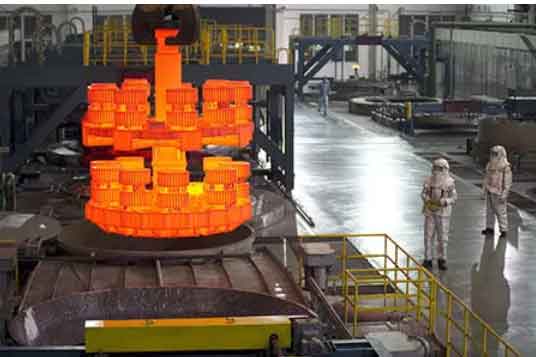Forging can make the forging billet segregation, uniform structure and reduce the banded structure, which is conducive to reducing the heat treatment deformation of cylindrical gear. However, forging defects will increase the heat treatment deformation of cylindrical gears. Therefore, we must pay attention to the rationality of forging process to ensure the quality stability of cylindrical gear.
1. Effect of streamline shape of forged metal fiber on heat treatment deformation of cylindrical gear
The streamline shape of metal fiber produced in the forging process has an obvious influence on the heat treatment deformation of cylindrical gear. The correct metal fiber streamline shape of the gear blank after forging should be symmetrically distributed along the outer contour of the gear blank. If the rough direction of the blank emblem is incorrect or skewed in the die bore during forging, the metal fiber streamline shape of the gear blank will be uneven and it is easy to cause the subsequent heat treatment deformation to increase.
2. Effect of forging ratio on heat treatment deformation of cylindrical gear
The internal spline shrinkage of cylindrical gears without forging or with forging ratio less than 1.3 is larger than that of cylindrical gears with forging ratio greater than 1.3. Increasing the forging ratio can make the structure of the forging blank compact, destroy the rolling streamline and eliminate the looseness. Therefore, the shrinkage of the internal spline of the cylindrical gear can be reduced. Some data show that if the forging ratio is controlled between 2 ~ 2.5, the heat treatment deformation of internal spline can be further reduced.
3. Effect of banded structure on heat treatment deformation of cylindrical gear
The strip structure will cause the anisotropy of steel. During carburizing, the carburized layer and structure will be uneven, resulting in the development of phase transformation and the uneven distribution of residual austenite during quenching, so as to form an uneven stress distribution, make the deformation amount and direction of cylindrical gear irregular, and finally make the cylindrical gear increase the deformation along the direction of strip structure after carburizing and quenching. Therefore, for the forged gear blank, the banded structure must be strictly controlled to make it less than grade 3.
4. Effect of forging overheating on heat treatment deformation of cylindrical gear
Forging overheating will coarsen the grain of steel, and it is easy to appear widmanstatten structure and carbon free bainite, both of which will increase the heat treatment deformation. Some data show that after carburizing and quenching of the same cylindrical gear with the same steel and the same process, the deformation of forged overheated parts is significantly different from that of normal parts. The shrinkage of internal splines of overheated parts increases, the variation of common normal line exceeds 20% and the tooth direction exceeds 30% ~ 35%. Therefore, attention should also be paid to the forging heating temperature, and electric furnace heating technology should be used as far as possible to control the heating temperature.

